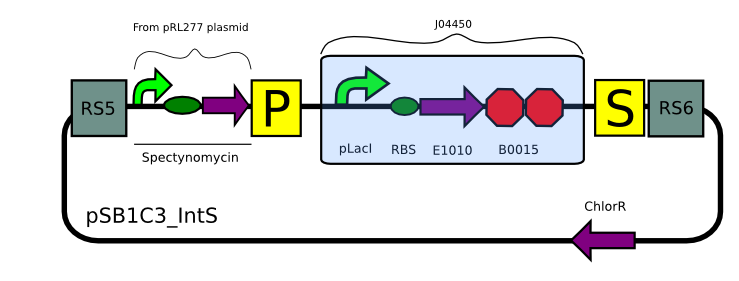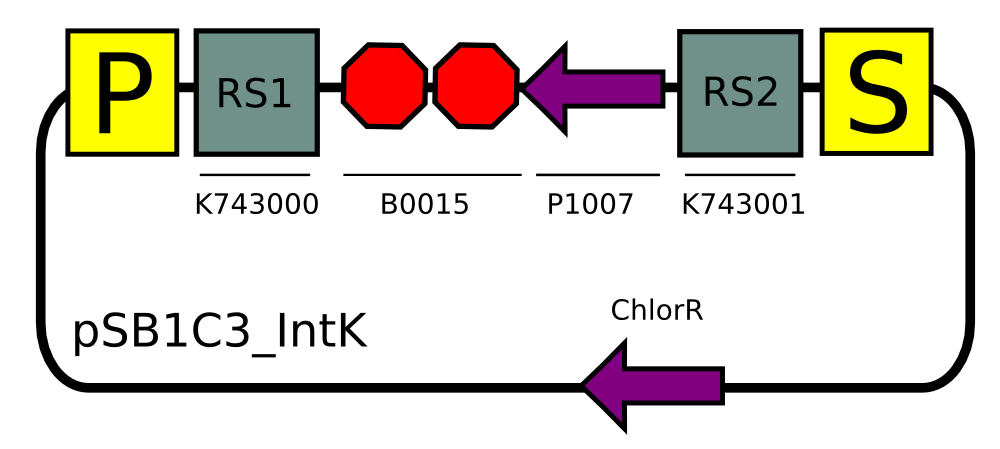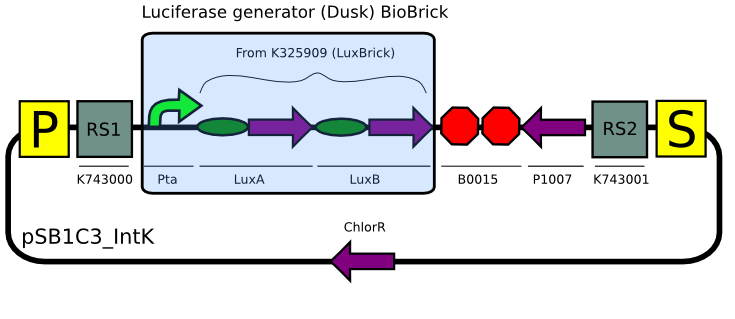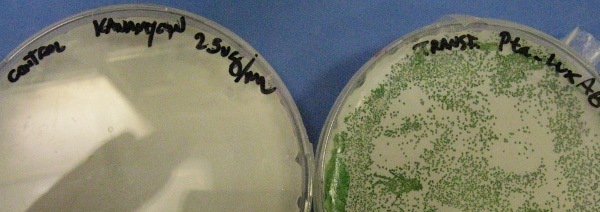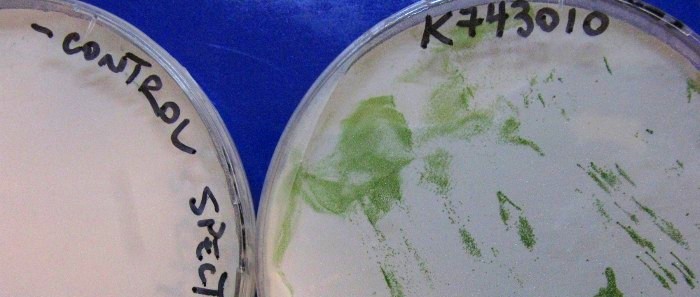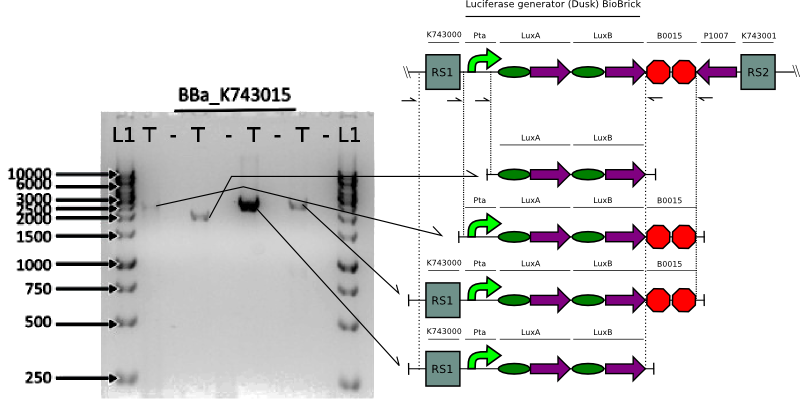Team:UC Chile/Cyanolux/Results short
From 2012.igem.org
(Difference between revisions)
| (15 intermediate revisions not shown) | |||
| Line 42: | Line 42: | ||
<h1>Characterization in Synechocystis</h1> | <h1>Characterization in Synechocystis</h1> | ||
| + | |||
| + | <br /> | ||
<h2>Transformation</h2> | <h2>Transformation</h2> | ||
| - | We used our plasmid backbones to transform Synechocystis PCC. 6803 | + | |
| + | We used our plasmid backbones to transform Synechocystis PCC. 6803 to verify that our initial design could indeed integrate into <i>Synechocystis's</i> genome. | ||
| + | |||
Transformation with pSB1C3_IntK (BBa_K743015): | Transformation with pSB1C3_IntK (BBa_K743015): | ||
| + | |||
[[File:Pta_LuxABvf.JPG| 600px| center]] | [[File:Pta_LuxABvf.JPG| 600px| center]] | ||
| + | |||
Transformation with pSB1C3_IntS (BBa_K743010): | Transformation with pSB1C3_IntS (BBa_K743010): | ||
| + | |||
[[File:Trans_IntS.JPG| 600px| center]] | [[File:Trans_IntS.JPG| 600px| center]] | ||
| + | |||
| + | |||
| + | After two weeks, colonies became apparent in the transformation plates for both plasmid backbones while in negative controls (transformations with no DNA) there was complete absence of surviving colonies. | ||
| + | |||
<h2>Verification of constructs</h2> | <h2>Verification of constructs</h2> | ||
| + | |||
We proceeded to verify the integration of the constructs in <i>Synechocystis</i> by doing multiple PCRs to amplify various parts. | We proceeded to verify the integration of the constructs in <i>Synechocystis</i> by doing multiple PCRs to amplify various parts. | ||
| - | + | [[File: UC_Chile-verification.jpg]] | |
| Line 68: | Line 80: | ||
<h3>Bioluminometer</h3> | <h3>Bioluminometer</h3> | ||
| - | We measured bioluminescence by adding directly the substrate to the cells and measuring light-output in a Luminometer. While we could measure bioluminescence of the positive LuxBrick E.coli controls, no apparent bioluminescence was seen in our <i>Synechocystis</i> cells. This | + | We measured bioluminescence by adding directly the substrate to the cells and measuring light-output in a Luminometer. |
| + | |||
| + | |||
| + | <br /> | ||
| + | <html><center><img src="https://static.igem.org/mediawiki/2012/6/6a/Kjasfkjhasdf.jpg" align="right" width="600"></center></html> | ||
| + | <br /> | ||
| + | <br /> | ||
| + | <br /> | ||
| + | <br /> | ||
| + | <br /> | ||
| + | <br /> | ||
| + | <br /> | ||
| + | <br /> | ||
| + | <br /> | ||
| + | <br /> | ||
| + | <br /> | ||
| + | <br /> | ||
| + | <br /> | ||
| + | <br /> | ||
| + | <br /> | ||
| + | |||
| + | |||
| + | While we could measure bioluminescence of the positive LuxBrick E.coli controls, no apparent bioluminescence was seen in our <i>Synechocystis</i> cells. This led us to think that the problem might be the size of the promoter, which if not long enough, would not be able to recruit necessary transcription factors for expression. | ||
| + | |||
<h3>High-sensitive camera</h3> | <h3>High-sensitive camera</h3> | ||
| - | |||
| - | David sent us some work he had done on luminescence assays in cyanobacteria. Following his methods we finally were able to see light | + | During the Latin America Jamboree, we had a chat with a couple of judges and a student from Universidad de los Andes, David Olarte, on how to induce Synechocystis with n-decanal. |
| + | |||
| + | David sent us some work he had done on luminescence assays in cyanobacteria. Following his methods we finally were able to see light emission, confirming presence of catalytically active luciferase. Thanks David! | ||
| + | |||
| + | <html><center><img src="https://static.igem.org/mediawiki/2012/7/7f/Cam.results.finalisimo.jpg" align="right" width="600"></center></html> | ||
| - | |||
<br /> | <br /> | ||
<br /> | <br /> | ||
| Line 82: | Line 119: | ||
<br /> | <br /> | ||
<br /> | <br /> | ||
| - | <br /><br /> | + | <br /> |
| + | <br /> | ||
| + | <br /> | ||
| + | <br /> | ||
| + | <br /> | ||
| + | <br /> | ||
| + | <br /> | ||
| + | <br /> | ||
<br /> | <br /> | ||
<br /> | <br /> | ||
| Line 91: | Line 135: | ||
<br /> | <br /> | ||
<br /> | <br /> | ||
| + | |||
| + | |||
<h1>Experimental Highlights</h1> | <h1>Experimental Highlights</h1> | ||
| - | < | + | <br /> |
| - | [https://2012.igem.org/Team:UC_Chile/Cyanolux/ | + | <br /> |
| - | </ | + | - Constructed two functional integration plasmids for <i>Synechocystis</i> PCC. 6803 |
| + | <br /> | ||
| + | <br /> | ||
| + | - Transformed <i>Synechocystis</i> PCC. 6803 with an optimized transformation protocol, available [https://2012.igem.org/Team:UC_Chile/Protocols#Transformation_of_Synechocystis_PCC._6803 here] | ||
| + | <br /> | ||
| + | <br /> | ||
| + | - Verified integration of constructs | ||
| + | <br /> | ||
| + | <br /> | ||
| + | - Confirmed expression of genes and activity of luciferase through a bioluminescence assay with exogenous substrate. | ||
| + | <br /> | ||
| + | <br /> | ||
| + | |||
| + | <html> | ||
| + | <a href="https://2012.igem.org/Team:UC_Chile/Cyanolux/Modelling"><img src="https://static.igem.org/mediawiki/2012/a/ab/UC_Chile-Continue_button.jpg" align="right"> | ||
| + | </html> | ||
{{UC_Chilefooter}} | {{UC_Chilefooter}} | ||
Latest revision as of 04:01, 27 October 2012
 "
"

